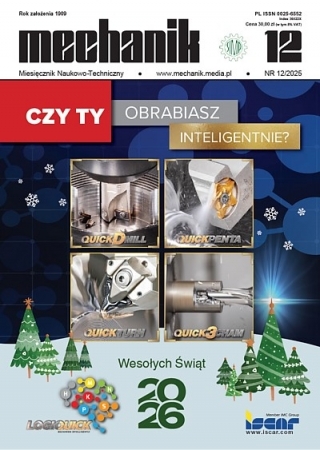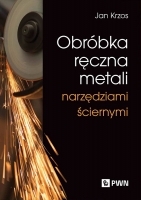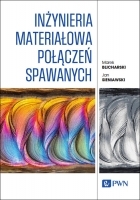Identyfikacja częstotliwości i postaci drgań maszyny AWJ w aspekcie drgań głowicy *
Identification of the vibration frequency and form of the AWJ machine in aspect of cutter head vibration
Mechanik nr 10/2017 - Obróbka - inne rodzaje
STRESZCZENIE: W ramach kompleksowych badań dotyczących wpływu drgań na proces cięcia wodno-ściernego AWJ (abrasive water jet) artykuł podejmuje temat identyfikacji własności modalnych maszyny z uwzględnieniem głowicy wodno-ściernej. Przeprowadzono eksperymentalną analizę modalną głównych podzespołów bramowej konstrukcji maszyny, tj. belki nośnej wraz z suportem narzędziowym i głowicą tnącą. Wyznaczenie własności modalnych maszyny pozwoliło na identyfikację tych drgań, które bezpośrednio wynikają z konstrukcji maszyny, oraz wskazanie ich w sygnale zarejestrowanym podczas cięcia.
SŁOWA KLUCZOWE: obróbka wodno-ścierna, test impulsowy, częstotliwości, postacie drgań
ABSTRACT: As part of a comprehensive study of influence of vibrations on the abrasive waterjet process, this article discusses about the identification of modal properties of the waterjet machine including the cutter head. The experimental modal analysis of the main gantry components of the machine construction was carried out, i.e. the carrier beam with the tool support and the cutter head. Determination of the modal properties of the machine allowed the identification of these vibrations, which are directly attributable to the construction of the machine and indicate them in the signal registered during the cutting.
KEYWORDS: abrasive waterjet, impulse test, vibration frequencies, vibrations forms
BIBLIOGRAFIA / BIBLIOGRAPHY:
- Monno M., Ravasio C. “The effect of cutting head vibrations on the surfaces generated by waterjet cutting”. International Journal of Machine Tools and Manufacture. 45, 3 (2005): s. 355–363.
- Percel V., Hreha P., Hloch S., Tozan H., Valicek J. “Vibration emission as a potential source of information for abrasive waterjet quality process control”. International Journal Advanced Manufacturing Technology. 61 (2012): s. 285–294.
- Crawford F.C. „Fale”. Warszawa: PWN, 1973.
- Gou N.S., Louis H., Meier G. “Surface structure and kerf geometry in abrasive waterjet cutting: formation and optimization”. 7th American Water Jet Conference Seattle, Washington, 28–31 August (1993), s. 1–25.
- Chao J., Geskin E.S., Chung Y. “Investigation of the dynamics of the surface topography formation during abrasive waterjet machining”. 11th International Symposium on Jet Cutting Technology, St Andrews, Scotland, 8–10 September (1992), s. 593–603.
- Chao J., Geskin E.S. “Experimental study of the striation formation and spectral analysis of the abrasive waterjet generated surfaces”. 7th American Water Jet Conference, Seattle, Washington, 28–31 August, 1993, s. 27–41.
- Hreha P., Radvanska A., Hloch S., Perzel V., Królczyk G., Monkova K. “Determination of vibration frequency depending on abrasive mass flow rate during abrasive water jet cutting”. International Journal Advanced Manufacturing Technology. 77 (2015): s. 763–774.
- Momber A.W., Mohan R.S., Kovacavic R. “On-line analysis of hydro-abrasive erosion of pre-cracked materials by acoustic emission”. Theoretical and Applied Fracture Mechanics. 31 (1999): s. 1–17.
- Valíček J., Hloch S. “Using acoustic sound pressure level for quality prediction of surfaces created by abrasive waterjet”. International Journal of Advanced Manufacturing Technology. 48, 1–4 (2010): s. 193–203, DOI: 10.1007/s00170-009-2277-3.
- Sokołowski A., Lis K. „Zintegrowany system do badań obrabiarek w warunkach przemysłowych – wybrane tory pomiarowe”. Prace Naukowe Katedry Budowy Maszyn. 1 (2009): s. 39–58.
- Wala T., Lis K. „Pomiary drgań podczas procesu cięcia strugą wodno-ścierną pod kątem oceny jakości powierzchni”. Mechanik. 8–9 (2016): s. 1084–1085.
- Wala T., Lis K. „Badanie oddziaływań siłowych podczas cięcia wysokociśnieniowego strugą wodno-ścierną”. Mechanik. 8–9 (2015): s. 415–423.





















